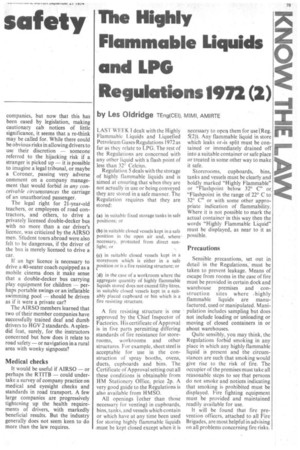The Highly Flammable Liquids and LPG Regulations1972 (2)
Page 81

If you've noticed an error in this article please click here to report it so we can fix it.
by Les Oldridge TEng(CEI), MIMI, AMIRTE LAST WEEK I dealt with the Highly Flammable Liquids and Liquefied Petroleum Gases.Regulations 1972 as far as they relate to LPG. The rest of the Regulations are concerned with any other liquid with a flash point of less than 32° Celcius.
Regulation 5 deals with the storage of highly flammable liquids and is aimed at ensuring that when they are not actually in use or being conveyed they are stored in a safe manner. The Regulation requires that they are stored:
(a) in suitable fixed storage tanks in safe positions; or (b) in suitable closed vessels kept in a safe position in the open air and, where. necessary, protected from direct sunlight; or
(c) in suitable closed vessels kept in a storeroom which is either in a safe position or is a fire resisting structure; or
(d) in the case of a workroom where the aggregate quantity of highly flammable liquids stored does not exceed fifty litres, in suitable closed vessels kept in a suitably placed cupboard or bin which is a fire resisting structure.
A fire resisting structure is one ' approved by the Chief Inspector of Factories. His certificate of Approval is in five parts permitting differing standards of fire resistance for storerooms, workrooms and other structures. For example, sheet steel is acceptable for use in the construction of spray booths, ovens, ducts, cupboards and bins. The Certificate of Approval setting out all these conditions is obtainable from HM Stationery Office, price 2p. A very good guide to the Regulations is also available from HMSO.
All openings .(other than those necessary for venting) in cupboards, bins, tanks, and vessels which contain or which have at any time been used for storing highly flammable liquids 'must be kept closed except when it is necessary to open them for use .(Reg. 5(2)). Any flammable liquid in store which leaks or.is split must be contained or immediately drained off into a suitable container or safe place or treated in some other way to make it safe.
Storerooms, cupboards, bins, tanks and vessels must be clearly and boldly marked "Highly Flammable" or "Flashpoint below 32° •C" or ."Flashpoint in the range of 22° C to 32° C" or with some other appropriate indication of flammability. Where it is not possible to mark the actual container in this way then the words "Highly Flammable Liquid" must be displayed, as near to it as possible.
Precautions
Sensible precautions, set out in detail in the Regulations, • must be taken to prevent leakage. Means of escape from rooms in the case of fire must be provided in certain dock and warehouse premises and construction sites where highly flammable liquids are manufactured, used or manipulated. Manipulation includes sampling but does not include loading or unloading or moving of closed containers in or about warehouses.
Quite sensibly, you may think, the Regulations forbid smoking in any place in which any highly ,flammable liquid is present and the circumstances are such that smoking would give rise to the risk of fire. The occupier of the premises must take all reasonable steps to see that persons do not smoke and notices indicating that smoking is prohibited must be displayed. Fire fighting equipment must be provided and maintained readily available for use.
It will be found that fire prevention officers, attached to all Fire Brigades, are most helpful in advising on all problems concerning fire risks.




























































































































































